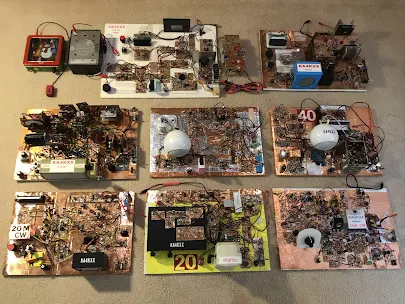Serving the worldwide community of radio-electronic homebrewers. Providing blog support to the SolderSmoke podcast: http://soldersmoke.com
Podcasting since 2005! Listen to Latest SolderSmoke
Thursday, June 22, 2023
Another Podcast -- "Lamp Talk"
Another Model Rocket that Lands like SpaceX -- With a Great Description of the Flight Computer, Software, and Design
Tuesday, June 20, 2023
Part 2: CuriousMarc Fixes an All-Discrete Counter -- "Like an IC, but in discrete form."
Marc nicely sums up this project with this line: "It's an IC but in discrete form!" On the same theme, he later says, "Who needs a logic analyzer when you can do a visual debug with neon bulbs?"
Very cool. Lots of troubleshooting and repair lessons in this video:
-- Again we see the benefits of paper manuals. (Todd K7TFC commented astutely on this under yesterday's post.)
-- 2N2222s to the rescue.
-- A surprisingly large number of bad transistors (6?) found. Why did they go bad?
-- Marc repeatedly says, "Let me poke around." Poking around is often important. Mark fixes the reset line after poking around. He is not sure HOW he has fixed it, but he has... by poking around. Sometimes this happens. Thank God for small favors.
-- Marc has some fancy HP board extenders. I am jealous.
-- He also has a cool de-soldering tool. More jealousy. Want one.
-- Marc's understanding of how the HP engineers had to put one of the flip-flops "on the edge of stability," and how his 'scope probe was capable of disturbing this stability.
-- Remember that those Nixies are TUBES with enough voltage on them to really zap you. So be careful in there. This is an especially dangerous mix of transistor tech and tube tech. With transistors you can work on them with the rig fired up. With tubes, well, you have to be careful.
Part III tomorrow.
Monday, June 19, 2023
CuriousMarc Repairs an old DISCRETE COMPONENT HP Frequency Counter
Saturday, June 17, 2023
Sam WN5C Builds a Michigan Mighty Mite and Takes it to Lake Thunderbird
Wednesday, June 14, 2023
Nine Homebrew Transceivers by Walter KA4KXX (and some QRP and QRO RC planes)
I
tried a Si5351 VFO once in the dual-band rig #4, but by the time I built the
QRP Labs kit with so much closely-spaced soldering, and then added
sufficient filtering and amplification to properly drive a 50 ohm load, I
was exhausted!
These nine were created during the past eight years, and
were preceded by eight more transceivers that I can document, but those have
all been disassembled, with many of the parts being used in these later
rigs. I build my transceivers to be
operated often, and since 20 Meters has been hot lately, for example, my POTA
Hunter log shows over 300 CW and SSB contacts in 2023 alone, so rig numbers 7 -
9 have been earning their keep lately.
In summary I have created a lifetime total of seventeen transceivers so far, and although I am nowhere near the fifty-plus tally of Pete N6QW, I did spend a lot of years instead homebrewing many radio-controlled model airplanes of my own design. Two photos show one example that I flew in the 2011 Blue Max Scale R/C Contest at the Fantasy of Flight Museum in Polk City, Florida against some stiff QRO competition.
—Walter KA4KXX
Tuesday, June 13, 2023
How they Make Raspberry Pi 4 Single Board Computers
Monday, June 12, 2023
Germany: Direct Conversion Receiver Success!
Dear Bill,
Thursday, June 8, 2023
Canadian Build of the Direct Conversion Receiver -- Do This in Your Town! (Video)
Tuesday, June 6, 2023
"Ham Radio Ireland" June 2023 edition (and Free Propagation Guide)
Get the latest edition here:
https://www.docdroid.net/VlSXkrD/crnews0623-pdf
Thanks to Steve Wright EI5DD. I had the great good fortune of running into my friend Michael EI0CL on the 17 meter band recently. Mike mentioned that he had been talking to Steve. So Steve is in good company.
Sunday, June 4, 2023
Can you ID this Receiver? Grayson Finds a Homebrew Receiver in Germany. From the GDR. Circuit? Schematic? Thermatrons?
Thursday, June 1, 2023
George Heron N2APB talks about Coherent CW at FDIM: Interview #7 by Bob Crane W8SX
It was great to hear George's voice again. I was a big fan of his "Chat with the Designers" podcast. And it was great to see that Pete Eaton WB9FLW (an old friend of SolderSmoke) was also involved in this presentation.
At FDIM George was talking about Coherent CW. Now, my views on CW have been made quite clear, but I am going to deliberately avoid snide comments about how Coherent CW might be a contradiction in terms. Thank you. I think this is something that Pete N6QW and I can agree on.
Nevertheless, this is all technically interesting. This reminds me of what happens with WSPR. But I wasn't quite sure what George was getting at with his discussion of the phase of the incoming signal -- I can see the need to get the receivers' narrow filter exactly on the transmitting station's frequency, but why the phase?
Here is Bob Crane's interview with George:
http://soldersmoke.com/N2APB23.mp3
And here are a couple of things with background info on CCW.
https://www.sigidwiki.com/wiki/Coherent_CW
http://www.arrl.org/files/file/Technology/tis/info/pdf/7509026.pdf
Thanks George, thanks Pete, and thanks Bob.

















